Stéphane Lathuilière
LTCI
Don't Forget your Inverse DDIM for Image Editing
May 14, 2025Abstract:The field of text-to-image generation has undergone significant advancements with the introduction of diffusion models. Nevertheless, the challenge of editing real images persists, as most methods are either computationally intensive or produce poor reconstructions. This paper introduces SAGE (Self-Attention Guidance for image Editing) - a novel technique leveraging pre-trained diffusion models for image editing. SAGE builds upon the DDIM algorithm and incorporates a novel guidance mechanism utilizing the self-attention layers of the diffusion U-Net. This mechanism computes a reconstruction objective based on attention maps generated during the inverse DDIM process, enabling efficient reconstruction of unedited regions without the need to precisely reconstruct the entire input image. Thus, SAGE directly addresses the key challenges in image editing. The superiority of SAGE over other methods is demonstrated through quantitative and qualitative evaluations and confirmed by a statistically validated comprehensive user study, in which all 47 surveyed users preferred SAGE over competing methods. Additionally, SAGE ranks as the top-performing method in seven out of 10 quantitative analyses and secures second and third places in the remaining three.
Di$\mathtt{[M]}$O: Distilling Masked Diffusion Models into One-step Generator
Mar 19, 2025Abstract:Masked Diffusion Models (MDMs) have emerged as a powerful generative modeling technique. Despite their remarkable results, they typically suffer from slow inference with several steps. In this paper, we propose Di$\mathtt{[M]}$O, a novel approach that distills masked diffusion models into a one-step generator. Di$\mathtt{[M]}$O addresses two key challenges: (1) the intractability of using intermediate-step information for one-step generation, which we solve through token-level distribution matching that optimizes model output logits by an 'on-policy framework' with the help of an auxiliary model; and (2) the lack of entropy in the initial distribution, which we address through a token initialization strategy that injects randomness while maintaining similarity to teacher training distribution. We show Di$\mathtt{[M]}$O's effectiveness on both class-conditional and text-conditional image generation, impressively achieving performance competitive to multi-step teacher outputs while drastically reducing inference time. To our knowledge, we are the first to successfully achieve one-step distillation of masked diffusion models and the first to apply discrete distillation to text-to-image generation, opening new paths for efficient generative modeling.
Group-robust Machine Unlearning
Mar 12, 2025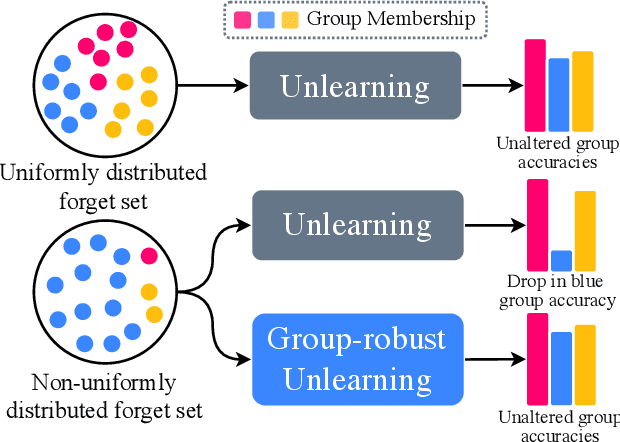

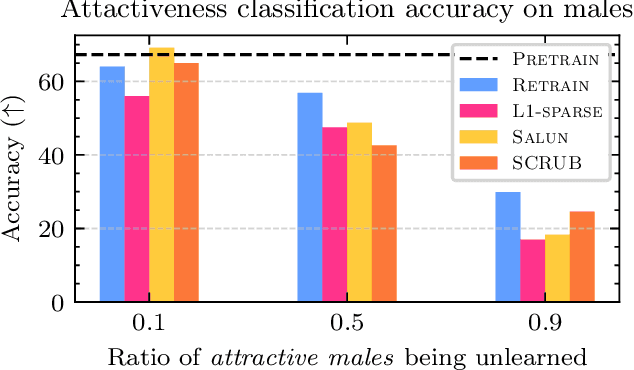

Abstract:Machine unlearning is an emerging paradigm to remove the influence of specific training data (i.e., the forget set) from a model while preserving its knowledge of the rest of the data (i.e., the retain set). Previous approaches assume the forget data to be uniformly distributed from all training datapoints. However, if the data to unlearn is dominant in one group, we empirically show that performance for this group degrades, leading to fairness issues. This work tackles the overlooked problem of non-uniformly distributed forget sets, which we call group-robust machine unlearning, by presenting a simple, effective strategy that mitigates the performance loss in dominant groups via sample distribution reweighting. Moreover, we present MIU (Mutual Information-aware Machine Unlearning), the first approach for group robustness in approximate machine unlearning. MIU minimizes the mutual information between model features and group information, achieving unlearning while reducing performance degradation in the dominant group of the forget set. Additionally, MIU exploits sample distribution reweighting and mutual information calibration with the original model to preserve group robustness. We conduct experiments on three datasets and show that MIU outperforms standard methods, achieving unlearning without compromising model robustness. Source code available at https://github.com/tdemin16/group-robust_machine_unlearning.
OVOSE: Open-Vocabulary Semantic Segmentation in Event-Based Cameras
Aug 18, 2024



Abstract:Event cameras, known for low-latency operation and superior performance in challenging lighting conditions, are suitable for sensitive computer vision tasks such as semantic segmentation in autonomous driving. However, challenges arise due to limited event-based data and the absence of large-scale segmentation benchmarks. Current works are confined to closed-set semantic segmentation, limiting their adaptability to other applications. In this paper, we introduce OVOSE, the first Open-Vocabulary Semantic Segmentation algorithm for Event cameras. OVOSE leverages synthetic event data and knowledge distillation from a pre-trained image-based foundation model to an event-based counterpart, effectively preserving spatial context and transferring open-vocabulary semantic segmentation capabilities. We evaluate the performance of OVOSE on two driving semantic segmentation datasets DDD17, and DSEC-Semantic, comparing it with existing conventional image open-vocabulary models adapted for event-based data. Similarly, we compare OVOSE with state-of-the-art methods designed for closed-set settings in unsupervised domain adaptation for event-based semantic segmentation. OVOSE demonstrates superior performance, showcasing its potential for real-world applications. The code is available at https://github.com/ram95d/OVOSE.
Specify and Edit: Overcoming Ambiguity in Text-Based Image Editing
Jul 29, 2024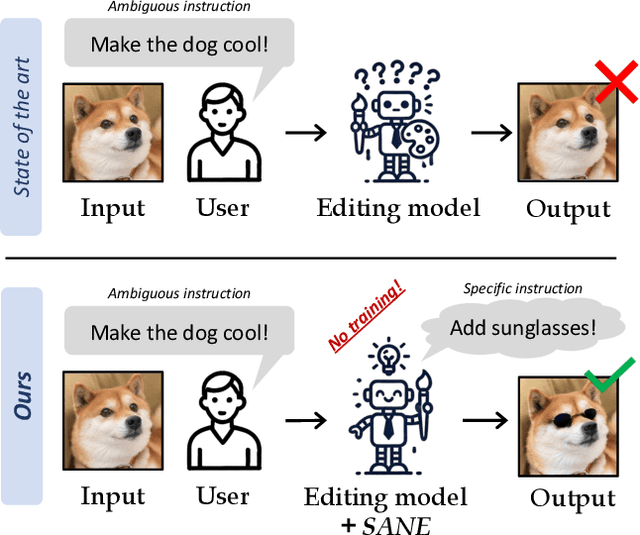
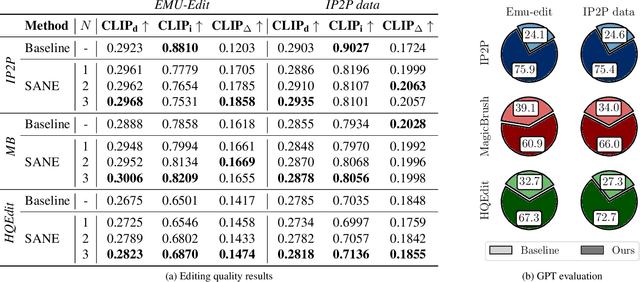


Abstract:Text-based editing diffusion models exhibit limited performance when the user's input instruction is ambiguous. To solve this problem, we propose $\textit{Specify ANd Edit}$ (SANE), a zero-shot inference pipeline for diffusion-based editing systems. We use a large language model (LLM) to decompose the input instruction into specific instructions, i.e. well-defined interventions to apply to the input image to satisfy the user's request. We benefit from the LLM-derived instructions along the original one, thanks to a novel denoising guidance strategy specifically designed for the task. Our experiments with three baselines and on two datasets demonstrate the benefits of SANE in all setups. Moreover, our pipeline improves the interpretability of editing models, and boosts the output diversity. We also demonstrate that our approach can be applied to any edit, whether ambiguous or not. Our code is public at https://github.com/fabvio/SANE.
Privacy-Preserving Adaptive Re-Identification without Image Transfer
Jul 17, 2024



Abstract:Re-Identification systems (Re-ID) are crucial for public safety but face the challenge of having to adapt to environments that differ from their training distribution. Furthermore, rigorous privacy protocols in public places are being enforced as apprehensions regarding individual freedom rise, adding layers of complexity to the deployment of accurate Re-ID systems in new environments. For example, in the European Union, the principles of ``Data Minimization'' and ``Purpose Limitation'' restrict the retention and processing of images to what is strictly necessary. These regulations pose a challenge to the conventional Re-ID training schemes that rely on centralizing data on servers. In this work, we present a novel setting for privacy-preserving Distributed Unsupervised Domain Adaptation for person Re-ID (DUDA-Rid) to address the problem of domain shift without requiring any image transfer outside the camera devices. To address this setting, we introduce Fed-Protoid, a novel solution that adapts person Re-ID models directly within the edge devices. Our proposed solution employs prototypes derived from the source domain to align feature statistics within edge devices. Those source prototypes are distributed across the edge devices to minimize a distributed Maximum Mean Discrepancy (MMD) loss tailored for the DUDA-Rid setting. Our experiments provide compelling evidence that Fed-Protoid outperforms all evaluated methods in terms of both accuracy and communication efficiency, all while maintaining data privacy.
One-Shot Unlearning of Personal Identities
Jul 16, 2024
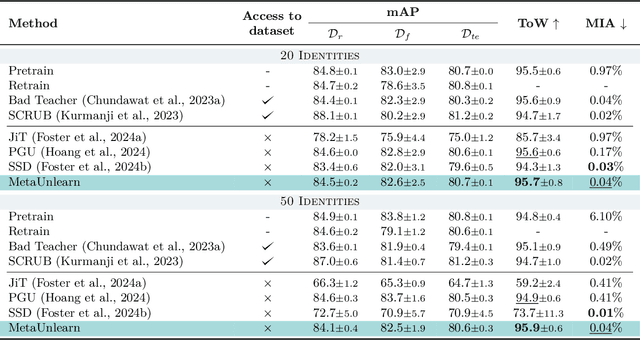
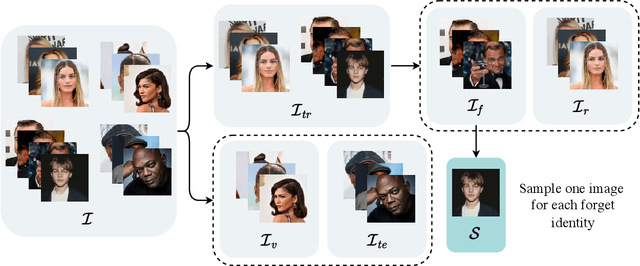
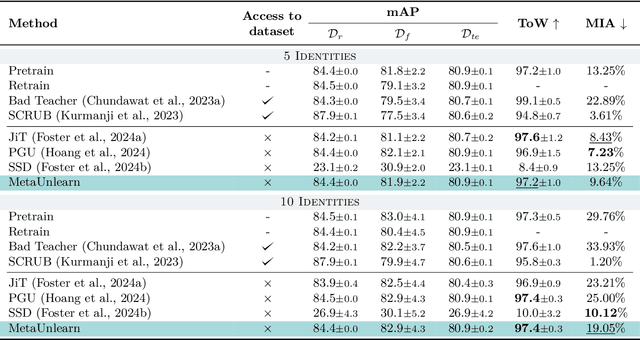
Abstract:Machine unlearning (MU) aims to erase data from a model as if it never saw them during training. To this extent, existing MU approaches assume complete or partial access to the training data, which can be limited over time due to privacy regulations. However, no setting or benchmark exists to probe the effectiveness of MU methods in such scenarios, i.e. when training data is missing. To fill this gap, we propose a novel task we call One-Shot Unlearning of Personal Identities (O-UPI) that evaluates unlearning models when the training data is not accessible. Specifically, we focus on the identity unlearning case, which is relevant due to current regulations requiring data deletion after training. To cope with data absence, we expect users to provide a portraiting picture to perform unlearning. To evaluate methods in O-UPI, we benchmark the forgetting on CelebA and CelebA-HQ datasets with different unlearning set sizes. We test applicable methods on this challenging benchmark, proposing also an effective method that meta-learns to forget identities from a single image. Our findings indicate that existing approaches struggle when data availability is limited, with greater difficulty when there is dissimilarity between provided samples and data used at training time. We will release the code and benchmark upon acceptance.
Less is more: Summarizing Patch Tokens for efficient Multi-Label Class-Incremental Learning
May 24, 2024Abstract:Prompt tuning has emerged as an effective rehearsal-free technique for class-incremental learning (CIL) that learns a tiny set of task-specific parameters (or prompts) to instruct a pre-trained transformer to learn on a sequence of tasks. Albeit effective, prompt tuning methods do not lend well in the multi-label class incremental learning (MLCIL) scenario (where an image contains multiple foreground classes) due to the ambiguity in selecting the correct prompt(s) corresponding to different foreground objects belonging to multiple tasks. To circumvent this issue we propose to eliminate the prompt selection mechanism by maintaining task-specific pathways, which allow us to learn representations that do not interact with the ones from the other tasks. Since independent pathways in truly incremental scenarios will result in an explosion of computation due to the quadratically complex multi-head self-attention (MSA) operation in prompt tuning, we propose to reduce the original patch token embeddings into summarized tokens. Prompt tuning is then applied to these fewer summarized tokens to compute the final representation. Our proposed method Multi-Label class incremental learning via summarising pAtch tokeN Embeddings (MULTI-LANE) enables learning disentangled task-specific representations in MLCIL while ensuring fast inference. We conduct experiments in common benchmarks and demonstrate that our MULTI-LANE achieves a new state-of-the-art in MLCIL. Additionally, we show that MULTI-LANE is also competitive in the CIL setting. Source code available at https://github.com/tdemin16/multi-lane
Source-Guided Similarity Preservation for Online Person Re-Identification
Feb 23, 2024Abstract:Online Unsupervised Domain Adaptation (OUDA) for person Re-Identification (Re-ID) is the task of continuously adapting a model trained on a well-annotated source domain dataset to a target domain observed as a data stream. In OUDA, person Re-ID models face two main challenges: catastrophic forgetting and domain shift. In this work, we propose a new Source-guided Similarity Preservation (S2P) framework to alleviate these two problems. Our framework is based on the extraction of a support set composed of source images that maximizes the similarity with the target data. This support set is used to identify feature similarities that must be preserved during the learning process. S2P can incorporate multiple existing UDA methods to mitigate catastrophic forgetting. Our experiments show that S2P outperforms previous state-of-the-art methods on multiple real-to-real and synthetic-to-real challenging OUDA benchmarks.
Collaborating Foundation models for Domain Generalized Semantic Segmentation
Dec 15, 2023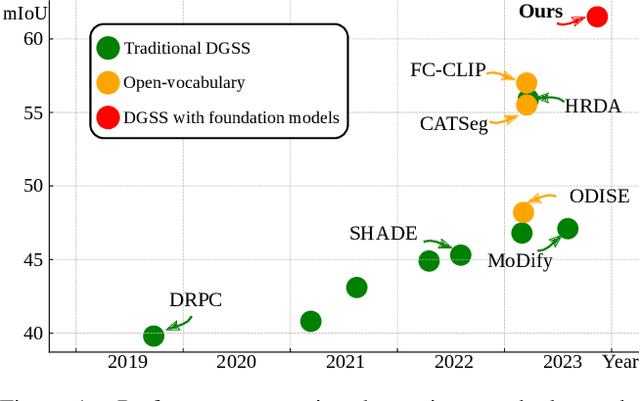
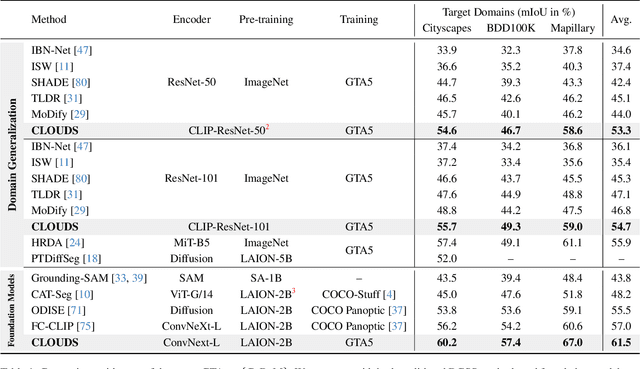

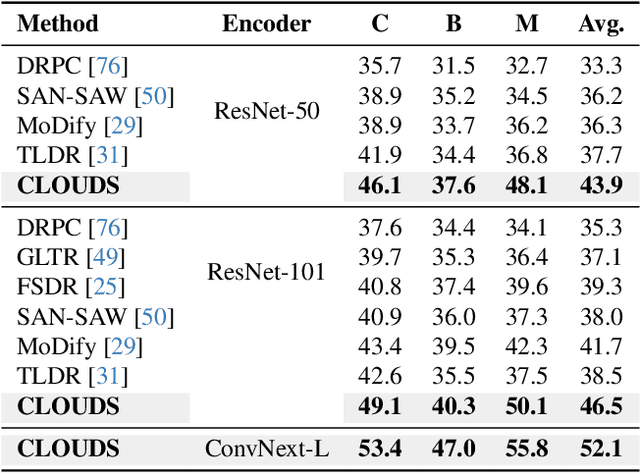
Abstract:Domain Generalized Semantic Segmentation (DGSS) deals with training a model on a labeled source domain with the aim of generalizing to unseen domains during inference. Existing DGSS methods typically effectuate robust features by means of Domain Randomization (DR). Such an approach is often limited as it can only account for style diversification and not content. In this work, we take an orthogonal approach to DGSS and propose to use an assembly of CoLlaborative FOUndation models for Domain Generalized Semantic Segmentation (CLOUDS). In detail, CLOUDS is a framework that integrates FMs of various kinds: (i) CLIP backbone for its robust feature representation, (ii) generative models to diversify the content, thereby covering various modes of the possible target distribution, and (iii) Segment Anything Model (SAM) for iteratively refining the predictions of the segmentation model. Extensive experiments show that our CLOUDS excels in adapting from synthetic to real DGSS benchmarks and under varying weather conditions, notably outperforming prior methods by 5.6% and 6.7% on averaged miou, respectively. The code is available at : https://github.com/yasserben/CLOUDS
 Add to Chrome
Add to Chrome Add to Firefox
Add to Firefox Add to Edge
Add to Edge